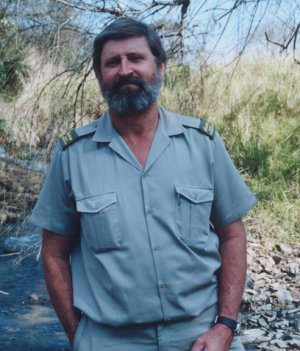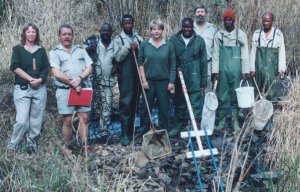
|
RHP |
South African
River Health Programme |

|
|
|
GAUTENG PROVINCE RIVER HEALTH PROGRAMME,
|
|
The Gauteng River Health Programme (RHP) is back on track under the leadership of Mr Piet Muller of the Gauteng Department of Agriculture, Conservation and Environment (DACE). The acting provincial champion, Piet Muller and his technical team have received practical training by members of the Mpumalanga RHP team and experts from the Institute for Water Quality Studies (IWQS) during the surveys done in the Elands River and Bronkhosrtspruit in Gauteng as part of the Olifants River catchment surveys. Two members of the team, Piet Muller and Hermien Roux also attended a 10 day course in SASS4 in Natal during March 2000, which included an intensive course in the identification of aquatic invertebrates. |
 |
| Piet Muller of DACE, the acting RHP provincial champion for Gauteng |
|
Gauteng programme
Gauteng is situated within three of the 19 identified national water management areas, the Olifants, the Crocodile-Marico, and the Upper Vaal region. Olifants Catchment The Elands River, Wilge River and the Bronkhorstspruit form part of the Olifants catchment and were surveyed during 1999 as part of the Mpumalanga surveys. The data collected was captured on the National Rivers Database by the Mpumalanga champion, Dr Johan Engelbrecht. Aerial surveys were undertaken by members of the Gauteng monitoring team to identify possible monitoring points in the Elands River system. These points were verified by Dr Engelbrecht and other members of the Mpumalanga team and were included in the National Rivers Database. Crocodile/Marico Catchment During the last seven months the team has concentrated on the sections of the Crocodile-Marico system which falls within the Gauteng provincial boundaries, and has up to date covered the Pienaars River, including the Morelettaspruit, Swavelpoortspruit and the Boekenhoutspruit, as well as the Apies River and the Soutpanspruit. Monitoring points were identified on the Hennops River, the Blaubankspruit and the lower Jukskei Rivers. The heavy rains during February and March 2000 has caused the rivers to flood so severely that most of the selected monitoring points in the Hennops River and lower Jukskei River have been totally destroyed. This has diverted the focus onto the upper Jukskei River. Monitoring points on this system will coincide with existing monitoring points where water quality sampling is currently taking place. Upper Vaal Catchment Aerial surveys on the Upper Vaal catchment is planned for October/November 2000. These surveys are aimed at familiarizing the team with the extent of the catchment as well as to identify monitoring points in addition to those already in use by Rand Water and other institutions. The Blesbokspruit Monitoring Committee was established as a sub-committee of the Blesbokspruit Forum for the specific reason of coordination and standardization of monitoring in the Blesbokspruit/Suikerbosrand River catchment. The provincial champion for Gauteng will coordinate all biomonitoring and collate all data for the National Rivers Database in the Upper Vaal region within the province. Active biomonitoring in the Upper Vaal region by the Gauteng team is scheduled for March - September 2001. Courses in fish identification, water quality sampling as well as toxicity testing protocols are scheduled for October/November 2000. This additional training will equip the team with substantial knowledge and insight to undertake their task as a fully fledged biomonitoring team. The importance of the work of the Gauteng RHP cannot be understated. The survival of present and future generations is inextricably linked to access to potable water. The success of the team hinges largely on the awareness and involvement of the public in coordinated efforts to safeguard water quality and quantity. |

|
Piet Muller and his biomonitoring team. Sean West (FAII - Fish Assemblage Integrity Index), Hermien Roux (SASS4 - South African Scoring System 4 & IHAS - Invertebrate Habitat Assessment System), Lorainne Mills (RVI - Riverine Vegetation Index), Sizakele Zwane (Biomonitoring), and nature conservation technical assistants, Richard Koko, Aron Matabane, Wilson Molaba, Job Motsamai and Jacob Makola. |
|
For further information, contact: Mr Piet Muller, Gauteng Provincial Champion Department of Agriculture, Conservation and Environment P O Box 8769, Johannesburg, 2000 Tel: (011) 355 1487, Fax: (011) 337 2292, E-mail: pietmu@gpg.gov.za |